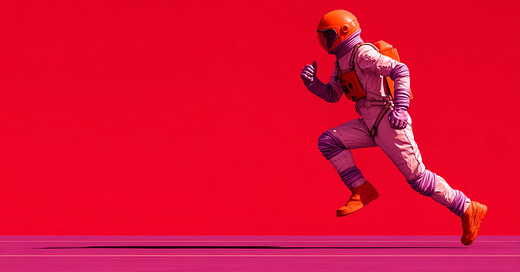#767 Create Dynamic Movement Art with AI: Master Kinetic Minimalism and Bold Action Scenes
Discover how strategic colour relationships and minimal backgrounds amplify the power of movement
From ancient Greek sculptures to modern AI art - the challenge remains the same: translating dynamic energy into static images. Here’s how… ✨ #AIArtDaily #creativeai #AIart
Hey there, 👋
Today we're exploring kinetic minimalism, where pure movement meets bold colour harmony in streamlined compositions.
The Art of Movement Illustration
Movement has challenged artists throughout history, from ancient Greek sculptures capturing athletic grace to Futurist paintings fragmenting motion across canvas. The goal remains constant - translating dynamic energy into static images that pulse with life. Traditional techniques used blur, repetition, and implied motion lines to suggest movement.
AI unlocks new possibilities for depicting kinetic energy through bold colour relationships and strategic simplification that amplifies rather than diminishes the sense of speed and purpose.
Understanding the Elements
Creating compelling movement illustrations relies on three core components:
Primary Foundation: Dynamic figure positioning that suggests continuous motion The foundation starts with body language that tells a story of movement in progress. Running figures lean forward, arms pump in opposition to legs, and every muscle suggests the next moment of action. This positioning must feel natural and energetic whilst maintaining clarity within minimal compositions. The pose becomes the engine that drives the entire artwork's energy.
Artistic Elements: Colour relationships that amplify kinetic energy Strategic colour choices transform static images into visual experiences that feel alive. Warm colours advance towards viewers, cool colours recede, and high contrast creates visual tension that mirrors physical energy. When colours work together effectively, they create emotional rhythm that matches the physical rhythm of movement.
Context & Atmosphere: Clean environments that focus attention on motion Minimal backgrounds eliminate distractions that might compete with the central action. Solid colours provide the perfect stage for dynamic figures, allowing every gesture and movement line to register clearly. This environmental simplicity creates the visual space that movement needs to feel powerful and unrestrained.
The Power of Strategic Reduction
Minimalist movement art succeeds through knowing what to eliminate rather than what to include. Every element that remains must earn its place by supporting the central narrative of motion. Unnecessary details drain energy from compositions, whilst well-chosen elements amplify the sense of dynamic action.
The most effective movement illustrations make viewers feel the rhythm and energy of the action through visual elements alone. Colour temperature, contrast levels, and spatial relationships all contribute to this kinetic experience without requiring complex backgrounds or detailed environments.
Style Approaches
Different artistic approaches create distinct results:
Athletic approach emphasises physical power and human achievement This method celebrates the beauty of bodies in motion, focusing on muscular tension, perfect form, and the grace that emerges from physical excellence. Colours tend towards energetic but natural palettes, and poses showcase the peak moments of athletic performance. The result inspires viewers and connects them to universal experiences of physical challenge.
Surreal approach creates dreamlike movement that defies natural laws Here, impossible beings move through impossible spaces, freed from the constraints of physics and logic. Colour relationships become more abstract and emotionally driven rather than naturally accurate. This style invites viewers into imaginative spaces where movement becomes pure expression rather than realistic action.
Graphic approach delivers maximum visual impact through bold simplification This method strips movement down to its essential visual elements, using strong geometric relationships and high-contrast colours to create immediate impact. Details disappear in favour of powerful silhouettes and dynamic colour interactions. The result works effectively across different scales and applications whilst maintaining strong visual presence.
Want to turn these ideas into actual art? Let's get down to the prompts...


